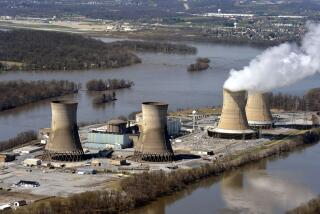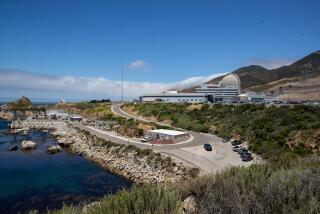Controversial Hanford Reactor to Be Mothballed
- Share via
WASHINGTON — The United States will mothball its largest plutonium production facility for nuclear weapons, the N Reactor at Hanford, Wash., the Energy Department announced Tuesday.
The department said the decision, approved by the White House, was based on a finding that the government’s plutonium stockpile is sufficient to meet foreseeable demands for new weapons.
The most immediate effect of the decision will be to reduce the department’s operating budget by about $150 million for the next fiscal year and to eliminate about 3,300 jobs at the Hanford Nuclear Reservation, the principal source of fissionable plutonium in U.S. nuclear weapons since the wartime Manhattan Project that created the first atomic bombs.
But the decision to mothball the 25-year-old reactor also lays to rest a simmering controversy over the safety of the graphite-moderated unit, which resembles in its basic design the Chernobyl reactor that exploded in the Soviet Union in April, 1986.
Although most safety experts agreed that the N Reactor shared few of the design vulnerabilities of the Chernobyl reactor, the Energy Department closed it in December, 1986, to carry out a $70-million safety “upgrade.”
The overhaul, which included the installation of a system for purging explosive hydrogen gas that might result if cooling water came into contact with the reactor’s graphite, will be completed in two months. Uranium fuel will then be removed and the reactor put in “cold standby” if weapons production programs require it, the agency announced late Tuesday.
It estimated that restarting the reactor from this condition would take two to three years.
Most of the plutonium used in newly fabricated warheads is recycled from obsolete weapons, experts said. The intermediate nuclear forces agreement signed by the United States and the Soviet Union in December, if ratified, is expected to increase the supply of salvage-able plutonium as ground-launched cruise and Pershing missiles are removed from Western Europe.
From the time that President John F. Kennedy inaugurated the N Reactor in 1963, it remained a unique hybrid facility, producing plutonium for weapons and electric power for civilian use. But Energy Department officials have said that even if the reactor were to be restarted, its remaining life span would be less than 10 years.
Intense irradiation has caused the graphite blocks that make up the reactor to expand. If it were restarted now, the officials said, the reactor would continue to swell until it literally hit the roof of its enclosure in the 1990s, at which time it would have to be completely rebuilt.
More to Read
Sign up for Essential California
The most important California stories and recommendations in your inbox every morning.
You may occasionally receive promotional content from the Los Angeles Times.












